Like the rustling of the old leaves in a cemetery, this is how our soul sounds when it is pushed by an unhealthy love into the still empty hole. After that nothing will be the same again, and our youth will be over without having had a chance to begin. We will only be able to make an ex-voto imagining what could have been, so as not to end up losing hope definitively.
Eugen Ehrlich
We open with this quote about death, even though we are going to talk about Eros, because it is well known that, despite the fact they seem like opposite poles, and they are, in truth they are closely related. The drive towards life, dynamism and the search for satisfaction are inseparable from the drive towards death, the return to the inorganic and dissolution. All human actions contain within themselves both principles. Perhaps that is why the French, or someone French, invented that expression which combines both ideas so well: la petite mort [the little death], in reference to the state of loss of consciousness that follows orgasm; a subject that has been studied in depth by Janniko R. Georgiadis, Rudie Kortekaas, Rutger Kuiper, Arie Nieuwenburg, Jan Pruim, AAT Simone Reinders and Gert Holstege (2006) in the article «Regional cerebral blood flow changes associated with clitorally induced orgasm in healthy women », European Journal of Neuroscience, Volume 24, Issue 11, pages 3305-3316.
In the exhibition “Morbo Queer / InsuMisa” (which translates roughly as Queer Thrills/ Disobedient Mass) by Anna Maria Staiano and Graham Bell Tornado [La Errería (House of Bent)], currently at Fundación La Posta, there is a piece which sums up pretty well that idea halfway between Eros and Thanatos.“Shirt lifter”, a kit for flirting or “Cruising Chatelaine” (2011-2013), which includes, amongst other elements, amulets and talismans (related to sexuality) and an ex-voto. Throughout history all these elements, together with reliquaries and crosses, have had some kind of religious meaning, a field of knowledge which profusely links life with death. In the case of Anna Maria Staiano’s Cruising Chatelaine (which refers us, in part, to 18th century Rococo jewellery), what at first could qualify as a reliquary, because it includes an image that looks like Saint Sebastian, but on closer inspection (in the exhibition at La Posta there is an enlargement of the image which makes that easier), we can see, by certain changes in the iconography, that it is not that saint, but rather a sufferer of pleasure in a BDSM session ―ropes included―, to which, in a daring gesture by the artist ―and to create the confusion to which we have referred before―, and give it an added religious meaning, a crown of thorns, which can also be seen in the exhibition, has been placed on his head: a framed object, like a vestige of that BDSM session, in which some miracle must have occurred, in gratitude for which the person who received the favour committed to the fulfillment of a promise, and hence the ex-voto in that Cruising Chatelaine, to remember and not forget.

“Shirt Lifter” in Impure (2019) by Anna Maria Staiano. It appears preceded by the text by Rosa Sanchís: “Run away cherubs, let the game begin”.
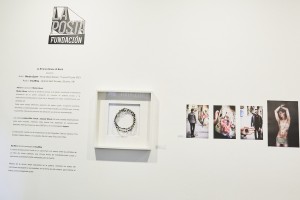
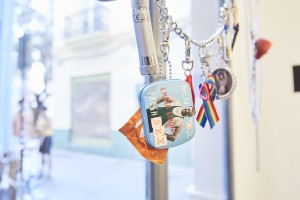
From the series “Shirt Lifter” (2016), on display at La Posta which includes the Cruising Chatelaine or Kit to flirt (in the Showcase); as well as the enlargement of the image in the reliquary (which we later see when we pay close attention to the fact that it is an ex-voto); the crown of thorns of the sufferer of pleasure, and the series of photographs taken by Vic Labadie with Joaquín Ruiz and Isaac Torres.
Talking about ex-votos, we must refer to the fact that not all of them are graphic or pictorial representations, but there are also sculptural ones, as Mathurin Méheut reminds us, in a drawing that is also riddled with references to gay iconography: “L’ex- vote”. Mathurin Méheut (1882-1958), ceramicist and engraver from French Brittany, an artesan more than an artist, collaborated with naturalists to depict life in the navy (he worked for the French Ministry of Defence, bedecking commercial ships such as SS Normandie), who is mainly remembered as the illustrator of Vieux métiers bretons (1944), by Florian Le Roy. Amongst these illustrations we recall “L’ex-voto”, an illustration in which some sailors are depicted carrying, as an ex-voto, something similar to the model of a ship, as a pledge of devotion and gratitude for sailors surviving sailors the dangers of the sea; an image which reminds us that ex-votos can also be not only graphic or pictorial, but also sculptural.
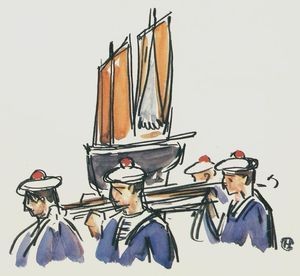
Mathurin Méheut: “L’ex-voto” (1944)
This image of “L’ex-voto” by Mathurin Méheut for les Vieux métiers bretons, forms part of a tradition that has fed gay ―and today by extension queer― iconography for decades. The permanence of these images in the work of so many artists has not yet been studied, for example, our beloved Genaro Lahuerta (the Lahuerta from the period before the failed coup d’état of 1936 and the subsequent Civil War in Spain, before he became a discreet painter of expressionist landscapes), as can be seen in all its splendour in this “Marine Procession” from 1930.

Genaro Lahuerta: “Marine Procession” (1930)
Ex-votos, like relics, beyond their appropriation by churches for religious purposes, are like the objet trouve that recalls a happy moment; a material object that facilitates that difficult relationship between things and ideas, and especially memories; an issue in which conceptual art has delved so deeply.
The appropriations between the different fields of representation do not end there. It would seem that religious imagery has completely appropriated the representation of BDSM. We can see it, for example, in the painting by Diego Velázquez: “Christ after the flagellation contemplated by the Christian soul” [it is often cited as “Christ contemplated by the Christian soul”], from 1628. A canvas of great dimensions (1.65 x 2.06) which is preserved in the National Gallery in London.
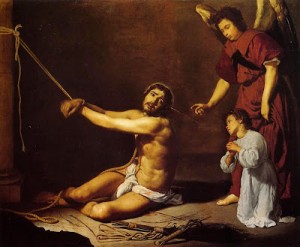
Diego Velázquez: “Christ after the flagellation contemplated by the Christian soul” (1628).
Pay attention to the presence in the foreground of the typical flogging instruments, which are usually part of BDSM practices.
Although it must be said that sometimes it is not known for sure which groups appropriate the images of which other groups.


The exhibition by Anna Maria Staiano and Graham Bell Tornado, a presentation of La Errería (House of Bent), is made up of two acts. In the first ―“Morbo Queer”―, Anna Maria exhibits her work in the Cube and in the La Posta Showcase, and in Act II ―“InsuMisa”―, Graham´s work expands into the urban space around La Posta in order to carry out their choral action, which includes the projection of the video art piece “Invocation of the Wayward Saints” (7 min, 2005). A choral action which, taking as a reference point a queer songbook written and illustrated by Bell Tornado between the covers of a book of Catholic masses (which later pop out onto the walls of the streets around La Posta), in a participatory vocal expression, reproduces slogans used in protests; and finally, a “Kuiraoke” (a karaoke of queer songs), presented by Diana DAMG, DJ and trans activist.
With this graphic material as a basis, Graham has created two posters to announce this “InsuMisa” action, in a faithful reflection of the imagery developed by him in multiple formats, which can be seen in all its splendour in the House of Bent in Xátiva (Valencia).

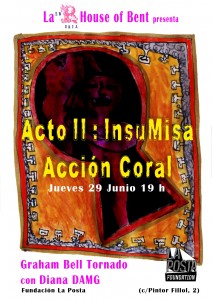
The posters for this exhibition, as well as the video “Invocations of The Naughty Saints” (which can be seen above, on our screen), are reminiscent of the works of Jack Smith, whose cinematographic work was shown at the Reina Sofía National Museum and Art Centre in 2008. It especially, reminds us of the film “Flaming Creatures” (1963), which was, as is well known, the most direct inspiration for Susan Sontag’s work “Notes on Camp” (1964). An essay in which the author defines camp as “a way of seeing the world”, as an ambition for greatness, something that wants to be so serious, that sometimes it ends up not being so, and then it moves towards tenderness, [although Susan Sontag does not cite it] like “Sunset Boulevard” (1950), with Gloria Swanson going down that staircase; in that sense, the perfect representation of failure turned art… …the art of living the failure that is life ―because it will lead us to death―, but without allowing the tragedy of life to be seen behind the glitter.
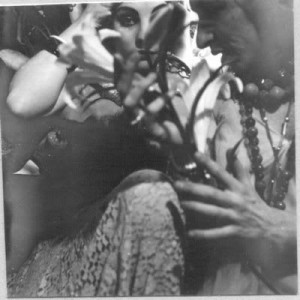 Jack Smith: “The Beautiful Book” (1962)
Jack Smith: “The Beautiful Book” (1962)

